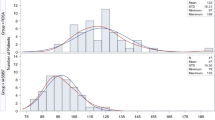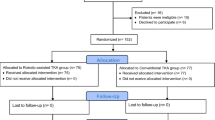Abstract
There is increasing adoption of robotic surgical technology in Total Knee Arthroplasty. The ROSA® knee system can be used in either image-based mode (using pre-operative calibrated radiographs) or imageless modes (using intra-operative bony registration). The Mako knee system is an image-based system (using a pre-operative CT scan). This study aimed to compare surgical accuracy between the ROSA and Mako systems with specific reference to joint line height, patella height, posterior condylar offset and tibial slope. This was a retrospective review of a prospectively collected data of the initial 50 consecutive ROSA TKAs and the initial 50 consecutive Mako TKAs performed by two high-volume surgeons. To determine the accuracy of component positioning, the immediate post-operative radiograph was reviewed and compared with the immediate pre-operative radiograph with regards to joint line height (JLH), patella height (PH), tibial slope (TS) and posterior condylar offset (PCO). Mean difference between pre- and post-operative radiographs using the ROSA knee system of joint line height was 0.47 mm (SD 0.95) posterior condylar offset 0.16 mm (SD 0.76), tibial slope 0.9 degrees (SD 1.6) and patella height 0.01 (SD 0.05). Mean difference using the MAKO knee system of joint line height was 0.26 (SD 1.08), posterior condylar offset −0.26 mm (SD 0.78), tibial slope 1.8 degrees and patella height 0.03. No significant difference was demonstrated between the accuracy of component positioning of the ROSA or MAKO knee systems. Our study is the first study to compare the accuracy of the ROSA and MAKO knee systems in total knee arthroplasty. Both systems are highly accurate in restoring native posterior condylar offset, joint line height, tibial slope and patella height in TKA with no significant difference demonstrated between the two groups.
Similar content being viewed by others
Data availability
Data sharing is not applicable to this article.
References
Yapp LZ, Scott CEH, MacDonald DJ, Howie CR, Simpson AHRW, Clement ND (2023) Primary knee arthroplasty for osteoarthritis restores patients’ health-related quality of life to normal population levels. Bone Joint J 105-B(4):365–372. https://doi.org/10.1302/0301-620X.105B4.BJJ-2022-0659.R1
No authors listed: National joint registry: 19th Annual report, 2022. https://reports.njrcentre.org.uk/Portals/0/PDFdownloads/NJR%2016th%20Annual%20Report%202019.pdf
Culliford D, Maskell J, Judge A, Cooper C, Prieto-Alhambra D, Arden NK (2015) Future projections of total hip and knee arthroplasty in the UK: results from the UK Clinical Practice Research Datalink. Osteoarthr Cartil 23(4):594–600
Muertizha M, Cai X, Ji B, Aimaiti A, Cao L (2022) Factors contributing to 1-year dissatisfaction after total knee arthroplasty: a nomogram prediction model. J Orthop Surg Res 17(1):367
Nakano N, Shoman H, Olavarria F et al (2020) Why are patients dissatisfied following a total knee replacement? A systematic review. Int Orthop (SICOT) 44:1971–2007. https://doi.org/10.1007/s00264-020-04607-9
Hadi M, Barlow T, Ahmed I et al (2015) Does malalignment affect revision rate in total knee replacements: a systematic review of the literature. Springerplus 4:835. https://doi.org/10.1186/s40064-015-1604-4
Brinkman J, Christopher Z, Moore M, Pollock J, Haglin JM, Bingham J (2022) Patient interest in robotic total joint arthroplasty is exponential: a 10-year Google trends analysis. Arthroplasty Today 15:13–18
Sires JD, Craik JD, Wilson CJ (2021) Accuracy of bone resection in MAKO total knee robotic-assisted surgery. J Knee Surg 34(07):745–748
Kayani B, Konan S, Pietrzak JRT, Haddad FS (2018) Iatrogenic Bone and Soft Tissue Trauma in Robotic-Arm Assisted Total Knee Arthroplasty Compared with Conventional Jig-Based Total Knee Arthroplasty: A Prospective Cohort Study and Validation of a New Classification System. J Arthroplast 33:2496–2501
Parratte S, Price AJ, Jeys LM, Jackson WF, Clarke HD (2019) Accuracy of a new robotically assisted technique for total knee arthroplasty: a cadaveric study. J Arthroplasty 34:2799–2803
Shin C, Crovetti C, Huo E, Lionberger D (2022) Unsatisfactory accuracy of recent robotic assisting system ROSA for total knee arthroplasty. J Exp Orthop 9(1):82
Sarmah SS, Patel S, Hossain FS, Haddad FS (2012) The radiological assessment of total and unicompartmental knee replacements. J Bone Jt Surg Ser B 94B(10):1321–1329. https://doi.org/10.1302/0301-620X.94B10.29411
Bellemans J, Vandenneucker OH, Surgeon O, Moemans A, Victor J, Banks S et al (2002) Fluoroscopic analysis of the kinematics of deep flexion in total knee arthroplasty. J Bone Jont Surg 84-B(1):50–53. https://doi.org/10.1302/0301-620X.84B1.0840050
Figgie HE, Goldberg VM, Heiple KG, Moller HS, Gordon NH (1986) The influence of tibial-patellofemoral location on function of the knee in patients with the posterior stabilized condylar knee prosthesis. J Bone Jt Surg––Ser A 68:1035
Clavé A, Le Henaff G, Roger T, Maisongrosse P, Mabit C, Dubrana F (2016) Joint line level in revision total knee replacement: assessment and functional results with an average of seven years follow-up. Int Orthop 40:1655–1662
van Lieshout WA, Valkering KP, Koenraadt KL, van Etten-Jamaludin FS, Kerkhoffs GM, van Geenen RC (2019) The negative effect of joint line elevation after total knee arthroplasty on outcome. Knee Surg, Sports Traumatol, Arthroscopy 1(27):1477–1486
Yang J-H, Seo J-G, Moon Y-W, Kim M-H (2009) Joint line changes after navigation-assisted mobile-bearing TKA. Orthopedics 32:35–39. https://doi.org/10.3928/01477447-20090915-57
Goutham GD, Jain VK, Sinha S, Arya RK (2020) Effect of posterior condylar offset in post operative range of motion in cruciate retaining and sacrificing TKR: A comparative analysis. J Orthop 1(20):342–346
Meneghini RM, Ritter MA, Pierson JL, Meding JB, Berend ME, Faris PM (2006) The effect of the Insall-Salvati ratio on outcome after total knee arthroplasty. J Arthroplast 21(6 Suppl 2):116–120
Adıyeke L, Kafadar AB, Erdoğan Ö, Gündüz ÇD (2022) The effect of tibial slope angle on clinical and functional results after mobile bearing total knee arthroplasty. J Orthop, Trauma Rehabilit. https://doi.org/10.1177/22104917221075828
Kayani B, Haddad FS (2019) Robotic total knee arthroplasty: clinical outcomes and directions for future research. Bone Joint Res 8(10):438–442
Funding
No funding was received for this study.
Author information
Authors and Affiliations
Contributions
HDR: data collection, analysis and writing of the manuscript. AM: data collection, analysis and writing of the manuscript. CM: data collection, analysis and writing of the manuscript. YA: writing of the manuscript. IP: writing of the manuscript. ETD: writing of the manuscript. ADS: conceptualisation of project, data collection, analysis and writing of the manuscript.
Corresponding author
Ethics declarations
Conflict of interest
Mr Davis has received study funding from Stryker and Smith and Nephew. Mr Sharma has received payment for lectures from Zimmer Biomet and Smith and Nephew. These were not related to this study.
Ethical approval
Institutional approval from The Royal Orthopaedic Hospital was received to carry out the study.
Consent for publication
Not applicable.
Additional information
Publisher's Note
Springer Nature remains neutral with regard to jurisdictional claims in published maps and institutional affiliations.
Rights and permissions
Springer Nature or its licensor (e.g. a society or other partner) holds exclusive rights to this article under a publishing agreement with the author(s) or other rightsholder(s); author self-archiving of the accepted manuscript version of this article is solely governed by the terms of such publishing agreement and applicable law.
About this article
Cite this article
Rajgor, H.D., Mayne, A., Munasinghe, C. et al. Mako versus ROSA: comparing surgical accuracy in robotic total knee arthroplasty. J Robotic Surg 18, 33 (2024). https://doi.org/10.1007/s11701-023-01786-6
Received:
Accepted:
Published:
DOI: https://doi.org/10.1007/s11701-023-01786-6




